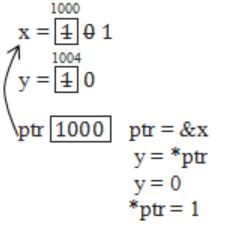Database-Management-System
October 17, 2023STQC-NIELIT STA 2021
October 17, 2023GATE 2017 [Set-2]
| Question 14 |
Consider the following function implemented in C:
void printxy (int x, int y) {
int *ptr;
x = 0;
ptr = &x;
y = *ptr;
*ptr = 1;
printf("%d,%d",x,y);
}
The output of invoking printxy(1, 1) is
| 0, 0 | |
| 0, 1 | |
| 1, 0 | |
| 1, 1 |
Question 14 Explanation:
printxy (int x, int y)
{
int *ptr;
x = 0;
ptr = &x;
y = *ptr;
*ptr = 1;

}
printxy (1, 1)

{
int *ptr;
x = 0;
ptr = &x;
y = *ptr;
*ptr = 1;

}
printxy (1, 1)

Correct Answer: C
Question 14 Explanation:
printxy (int x, int y)
{
int *ptr;
x = 0;
ptr = &x;
y = *ptr;
*ptr = 1;

}
printxy (1, 1)

{
int *ptr;
x = 0;
ptr = &x;
y = *ptr;
*ptr = 1;

}
printxy (1, 1)

![GATE 2017 [Set-2]](https://solutionsadda.in/wp-content/uploads/2019/05/green-new-logo.png)